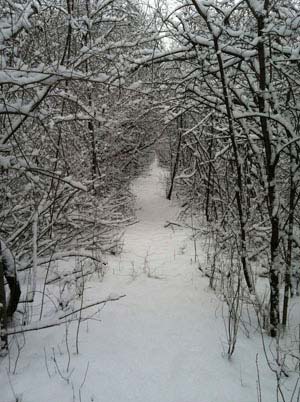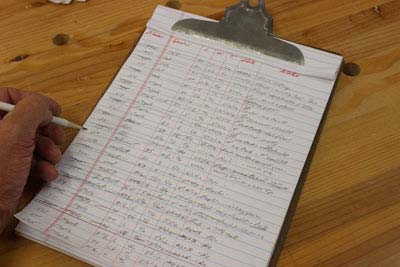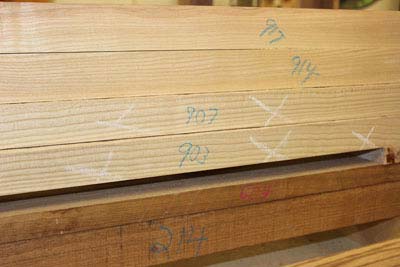
 by Steven D. Johnson
by Steven D. Johnson
Racine, Wisconsin
This month:
•
Make Like a Squirrel - Stock Up Your Shop...
...And Get Prepared For a Productive Winter Woodworking Season!
•
How Deep Is Your Dado?
...A Dado Depth Torture Test
Prep Your Shop For Winter
Click on any picture to see a larger version.
The squirrels are getting serious now. Up here in the northern latitudes it will soon be barely habitable for man or beast. Most of us take our cues from the squirrels. You see, for the past few months they have scampered through the trees, chased one another through the flowers and tall lush grass, and chattered incessantly about who-only-knows what, seemingly without a care in the world. But in the past couple of weeks, all that has changed. Their playful mood is gone. They are busy. They are serious. They are stocking up on food, hiding nuts in hundreds of secret places, working hard to get ready for those long cruel cold months ahead. A wise woodworker will definitely follow their lead.
We, too, frittered away the summer months frolicking in the sunshine, enjoying the clear clean air and the carefree lifestyle, but we, too, must now get back to "serious."

|
Figure 1 - Carrying lumber down this
path is not as much fun as it looks
|
Northern-dwellers generally enjoy a little extra disposable income in the summer. Those gargantuan heating bills are just a bitter memory. We rarely need air conditioning. With daylight savings time and long days, we burn the lights much less. In the winter we wash clothes constantly… when you wear nine layers just to stay alive, there is a lot more to wash. In the summer we get dirtier, but we wear less. In the summer we even eat less, our bodies just don't need those extra thousand calories a day to avoid hypothermia. We accumulate some serious cash in the summer.
So when there is a little extra money we learn to follow the squirrels' lead, and lay in supplies for the winter. For me, that is mostly wood, but I also stock up on glue and finishes because they will quickly freeze solid if the UPS driver leaves them by the door outside for more than a few minutes.
Late summer and fall is also the time we northerners make a summer-to-winter "changeover" in the shop. The dehumidifier goes into storage and the portable heaters get reinstalled. In the summer the windows of my shop are always open, in the winter they are always shut, so I need to clean them now while I can still get to both sides easily. I clearly remember one winter I brilliantly decided to use a Windex-soaked paper towel outside to quickly wipe off a particularly bothersome smudge. The towel promptly froze to the window and remained stuck there until May. The muddy garden shoes go into the basement and the calf-high fur-lined boots come back out. I use those to get from house to shop and back. There is also a pair of special high-traction waterproof insulated rubber boots I use when shoveling snow. Goodbye sneakers… I look forward to seeing you again soon… hello, arctic hiking boots. Then, of course, there is the fan that I had hoped to need this summer, and only used twice. It can go back to the basement. The umbrella helps during spring and summer rains, but would be a liability in a gale-force blizzard, so it too, can be stowed. The broom by my shop door gets replaced with a snow shovel, and the list goes on.
In addition to changing out basic "equipment," fall is a great time for a cleanup. Of course there will be seven to eight tons of leaves that will beguile me for three to four weeks, and there are trees and shrubs that must be trimmed, mulched, and readied for winter, but I am really talking about shop cleanup. Not your regular run-of-the-mill dust, vacuum, and take out the chips cleaning… I'm talking about a detailed "scrub-down-move-things-get-under-and-behind-stuff" cleaning. It is an exercise best done with open windows and a couple of energy drinks close at hand.
This must all sound a bit "nuts" to life-long residents of warmer southern climes, but there are some corollaries. Having lived in the South before, I know that summer can actually be an expensive time of the year, what with 24/7 air-conditioning. Chances are good that southern-dwellers are anticipating soon having some extra "seasonal" cash on hand. You may also be stocking up on wood and supplies for all your winter projects. You may be making some seasonal conversions in your shop, perhaps covering your window-unit air conditioner or installing a dehumidifier, or performing your own fall cleaning ritual. I'm sure some of you will even have to hang up your shorts and get out the long pants soon.
Wherever you live and whatever your season-changing ritual, it is time to take a squirrel-cue and get ready for an outstanding winter full of great projects, enjoyable shop time and a passel of fun. Here are a few additional down to earth ideas to make sure that the winter of 2013-14 is your best woodworking season ever!
Plan… There are probably a dozen projects you want to do in the shop this winter, and you will not (at least most likely you will not) get to them all. So prioritize. If Aunt Millie's new mirror and Bobby and Byron's new bunk beds are essential, put them at the top of the list. If the widget box for cousin Wilma is just a whim, put that at the bottom of the list. With careful planning and prioritization, there will never be a panic in your shop. If a few projects don't get finished (or started, for that matter) they should be the low priority projects and you can put them on next year's list!
With the project list in order and in hand, you can start to lay-in supplies. Especially with winter approaching, I like to decide right up front what species of wood I will use for each project. Extra cash notwithstanding, who wants to schlep boards from mill to truck and truck to shop in three feet of snow? Just to be sure, this time of year when calculating the number of board feet I will need, I add 15 or even 20% to provide a margin for error. I make notes of any extra thick or wide material I may need for each project and any particularly complicated pieces that may require "do-overs." Then, after checking my current stock, I'm ready to go shopping.
Stock up… Whether you have extra cash now because of the summer, or extra cash coming in spite of it, stock up! Wood, glue, sandpaper, wood, a couple of extra band saw blades, wood, finishing supplies, those new sharpening stones, and wood are all things that you will need… you might as well get them now.
Clean up… Whatever winter weather your locale receives, it is highly likely that giving your shop a substantial cleaning will be more enjoyable to do now than in December. Plus, who wants to start the very best time of the woodworking year with a dirty shop?

|
Figure 2 - A simple lumber list helps
save time in the shop
|
Organize… An organized shop is a more efficient, and frankly, fun, shop. In all likelihood, your tools are already efficiently organized. If not, go way back to our tutorial on the "5S" system in the Newsletter archives. Knowing woodworkers as I do, I'm pretty confident you can find that 5/32" drill bit in 5 seconds flat and can lay your hands on that quarter-inch swan neck chisel without even looking. But what about your wood? I've seen otherwise efficient woodworkers spend an hour looking for a prized piece of ropey figured cherry they remember buying a year ago, but just cannot seem to find. Hours later, they finally uncover it, only to realize it is either not wide enough, long enough, or thick enough for their purpose.
I use a very simple system to keep my wood organized. As each piece comes in the door, it gets a number written on one long edge and on at least one of the ends. I use crayons. Being frugal and well past the age of finding crayons in a box or under a chair in the house, I occasionally help myself to one of the little packs of crayons that restaurants provide for children (hey, I'm a kid at heart… and I tip well!).

|
Figure 3 - Easy to see that the boards on the top are ash but
how wide are they? The numbering system gives the details.
|
The number assigned to each piece of wood is somewhat arbitrary. I'm not yet well enough organized to diligently track what numbers are used and which are available, so I just use a semi-random three-digit number. Perhaps on my last trip to the lumber mill I numbered all the boards with numbers starting with "9," i.e. 916, 917, 918, etc. Next trip I will go back to "1" and start with 101, 102, etc. There may be a duplicate or two in my system; I'm not sure… I try to be careful.
The board number is then entered into a simple handwritten list with species, length, width, thickness, condition (usually referring to rough cut or skip-planed), date acquired, and any special notes. When I use a board, it gets crossed off the "available" list.
When I need a particular piece of wood for a project all I have to do is consult the list and know if I have something that will work. If I have the board, it is relatively easy to find. It can be hard to tell cherry from maple when looking at the edges of dozens of boards stacked in a dimly lit barn, and from the edge there is no way to know how wide the board is, its condition, or sometimes even its length. But the numbering system makes it easy.
This year I may go "high-tech" and put the list into a spreadsheet. That may seem a little overly fancy for a down-to-earth woodworking shop, but I think the ability to sort the list by species or by date acquired will help me be more organized and speed up my work. A spreadsheet will also help eliminate the possibility of using a duplicate number.
Admittedly, if you have stacks and stacks of wood, identifying, measuring, and labeling all those boards the first time will be a daunting task. But it will pay off in the future. And once you have a system, recording the details of each new piece of wood as it comes into the shop is fast and easy.
This is a short list of winter-preparedness measures for the woodworking shop… you undoubtedly have more, perhaps some that are specific to your climate or the type of woodworking you do. If you have additional ideas to help out other woodworkers, let us know. You can contribute to our Blog conversation on this topic by clicking here.
(Page 1 of 2)
1
2
Next Page
Return to Wood News front page
